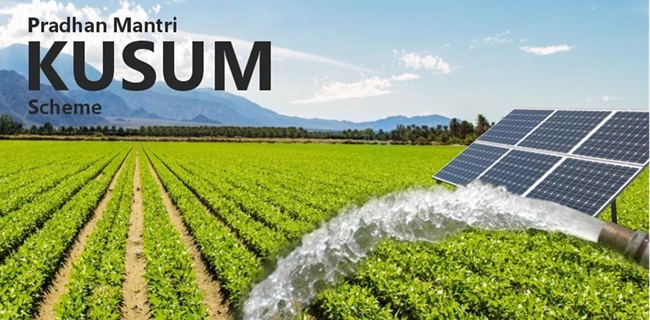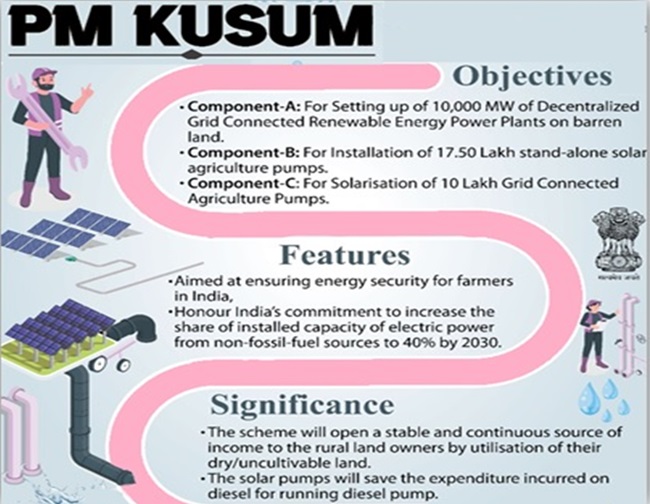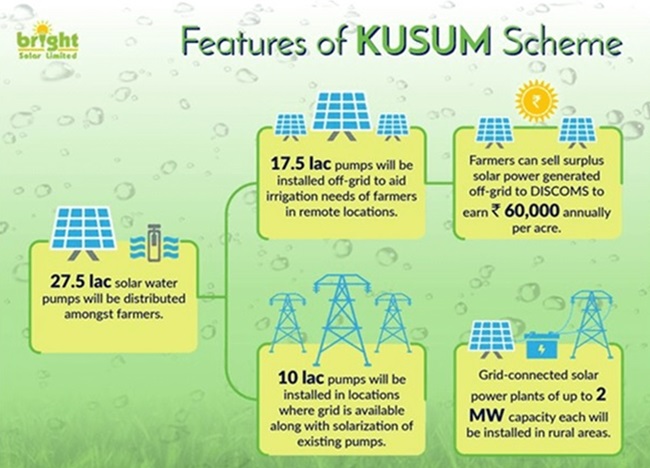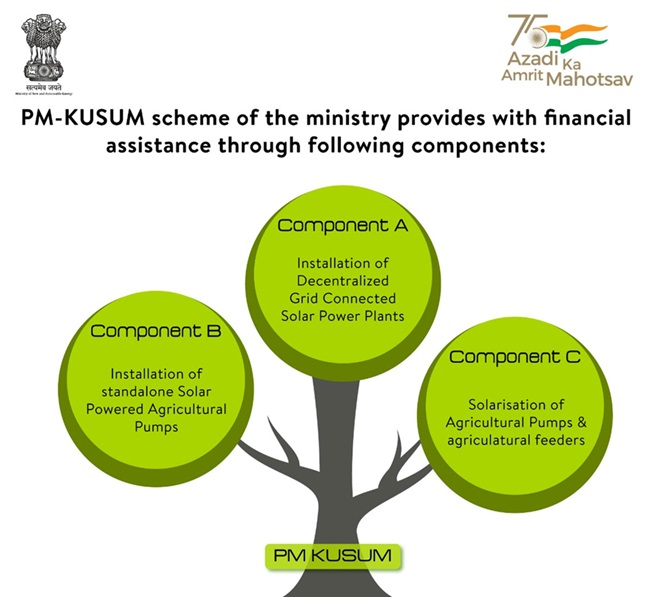The PM-KUSUM Scheme was launched in 2019 for de-dieselisation of the farm sector and enhancing the income of farmers.

Ministry: Ministry of New and Renewable Energy
Target: Add Solar capacity of about 34,800 MW by March 2026
Type: central sector scheme
Eligibility
- An individual farmer.
- A group of farmers.
- Farmer producer organization.
- Panchayat.
- Co-operatives.
- Water User Associations.

Objectives
- Replacing high-cost diesel with low-cost solar power.
- Giving farmers the opportunity to use their barren lands through setting up solar power plants for energy generation.
- Integrating renewable energy into farmers’ irrigation practices.
- Helping farmers access solar water pumps at subsidized rates.
- Reducing the burden of agricultural power subsidy on states and improving the financial health of discoms.
Features of KUSUM Scheme

Components of PM-KUSUM Scheme: The Scheme consists of three components:

Component A: Setting up of 10,000 MW of Decentralized Ground/ Stilt Mounted Grid Connected Solar or other Renewable Energy based Power Plants by the farmers on their land.
- Farmers can install Renewable Energy Power Plants (500 kW to 2 MW) on their own land, either individually or with groups/cooperatives. ng farmers an nue to utilize their ren land through ing up of solar power ts for energy eration.
- Solar panels can be installed on cultivable land with crops grown below.
- DISCOMs will purchase solar power at a feed-in-tariff (FiT) set by the State Electricity Regulatory Commission (SERC).
- Procurement Based Incentive (PBI) @ 40 paise/kWh or Rs. 6.60 lakhs/MW/year, whichever is less, will be provided for the first five years by MNRE to DISCOMs, for buying the power from farmers/developers
- The project site should be within 5 km of the nearest sub-station.
Component B: Installation of 14 Lakh Stand-alone Solar Agriculture Pumps.
- Individual farmers will be supported to install standalone solar Agriculture pumps of capacity up to 15 HP in off-grid areas, where grid supply is not available.
- Centre and state to share 30% of pump cost each; farmer to provide the remaining 40% (can access bank loan for up to 30% of the cost).
- In NER/Hilly Region and Islands, CFA of 50%, State Government subsidy 30%, Remaining 20% by the farmer
- In case the State Government is not in a position to give its share of subsidy of 30%, farmers can still set up solar pumps with only Central Financial Assistance.
Component C: Solarisation of 35 Lakh Grid Connected Agriculture Pumps including Feeder Level Solarization.
- Individual Pump Solarisation (IPS)
Benefits of the Scheme
- This scheme will provide a stable and continuous source of income for rural landowners by utilizing their dry/barren land for a period of 25 years.
- When cultivated fields are selected for setting up solar power projects, farmers can continue to grow crops as the solar panels will be installed above the minimum height.
- Solar pumps will save the cost of diesel for running diesel pumps and provide farmers a reliable source of irrigation through solar pumps besides preventing harmful pollution caused by running diesel pumps.
- Farmers can sell the electricity generated from solar plants to electricity distribution companies.
- This scheme will also promote green economy.



